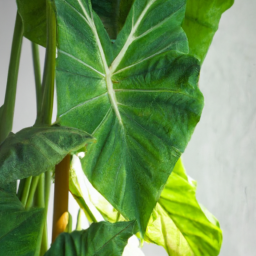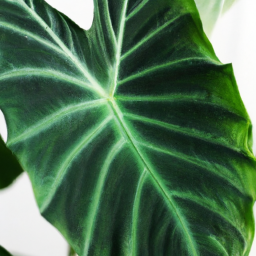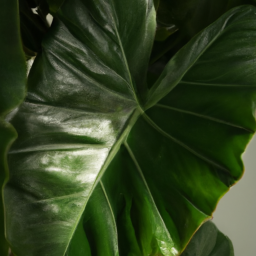
Are you looking to add some greenery to your indoor space? Elephant ear plants are a popular choice for bringing a touch of the tropics indoors. In this blog post, we’ll explore the different types of elephant ear plants that thrive in indoor environments. Whether you’re a seasoned plant parent or just starting out, there’s a perfect elephant ear plant for every space and skill level. So let’s dive in and discover the beauty and variety of these stunning plants!
Different Varieties of Elephant Ear Plants for Indoor Spaces
When it comes to adding a touch of tropical flair to your indoor space, elephant ear plants are a popular choice. These large, lush plants are known for their oversized, heart-shaped leaves that resemble the ears of an elephant. There are several different varieties of elephant ear plants that are well-suited for indoor environments, each with its own unique characteristics and care requirements. In this guide, we will explore some of the most popular types of elephant ear plants for indoor spaces.
1. Alocasia
Alocasia is a genus of flowering plants in the Araceae family that is commonly known as elephant ear plants. These plants are prized for their large, glossy leaves that come in a variety of shapes and colors. Some popular varieties of Alocasia include Alocasia Amazonica, also known as the African mask plant, which has striking dark green leaves with white veins, and Alocasia Polly, which features arrowhead-shaped leaves with a deep green color.
When growing Alocasia plants indoors, it is important to provide them with bright, indirect light and a humid environment. These plants prefer well-draining soil and should be watered regularly, allowing the top inch of soil to dry out between waterings. Alocasia plants are sensitive to cold temperatures and should be kept in a warm, draft-free location.
To promote healthy growth, Alocasia plants can benefit from regular fertilization during the growing season. It is also important to keep an eye out for pests such as spider mites and aphids, which can be common problems for these plants. With proper care, Alocasia plants can thrive and add a touch of exotic beauty to your indoor space.
2. Colocasia
Colocasia is another genus of flowering plants in the Araceae family that is commonly referred to as elephant ear plants. These plants are known for their large, heart-shaped leaves that come in a range of colors and patterns. Some popular varieties of Colocasia include Colocasia esculenta, also known as taro, which has green or purple leaves and is commonly used in cooking, and Colocasia Black Magic, which features deep purple-black leaves.
When growing Colocasia plants indoors, it is important to provide them with bright, indirect light and a warm, humid environment. These plants prefer moist, well-draining soil and should be watered regularly, keeping the soil consistently moist but not waterlogged. Colocasia plants are sensitive to cold temperatures and should be kept in a warm location away from drafts.
To encourage healthy growth, Colocasia plants can benefit from regular fertilization during the growing season. It is also important to watch out for pests such as aphids and mealybugs, which can be common issues for these plants. With proper care, Colocasia plants can thrive and bring a touch of tropical elegance to your indoor space.
3. Xanthosoma
Xanthosoma is a genus of flowering plants in the Araceae family that is closely related to Alocasia and Colocasia. These plants are known for their large, arrowhead-shaped leaves that come in a variety of colors and patterns. Some popular varieties of Xanthosoma include Xanthosoma sagittifolium, also known as malanga, which has green or purple leaves and is commonly used in cooking, and Xanthosoma Lime Zinger, which features lime green leaves with dark purple veins.
When growing Xanthosoma plants indoors, it is important to provide them with bright, indirect light and a warm, humid environment. These plants prefer well-draining soil and should be watered regularly, allowing the top inch of soil to dry out between waterings. Xanthosoma plants are sensitive to cold temperatures and should be kept in a warm location away from drafts.
To promote healthy growth, Xanthosoma plants can benefit from regular fertilization during the growing season. It is also important to keep an eye out for pests such as spider mites and scale insects, which can be common problems for these plants. With proper care, Xanthosoma plants can thrive and add a touch of exotic beauty to your indoor space.

Best Elephant Ear Plant Species for Indoor Gardening
Introduction
When it comes to indoor gardening, elephant ear plants are a popular choice due to their large, tropical-looking leaves that can add a touch of exotic beauty to any space. There are several different types of elephant ear plants that can thrive indoors, each with its own unique characteristics and care requirements. In this guide, we will explore some of the best elephant ear plant species for indoor gardening and provide tips on how to care for them effectively.
Types of Elephant Ear Plants
One of the most popular types of elephant ear plants for indoor gardening is the Alocasia Polly. This plant features striking dark green leaves with contrasting white veins, giving it a dramatic and eye-catching appearance. Alocasia Polly prefers bright, indirect light and thrives in humid environments, making it an ideal choice for indoor spaces with good natural light and regular misting.
Another popular elephant ear plant species for indoor gardening is the Colocasia Esculenta, also known as the Taro plant. This plant has large, heart-shaped leaves that come in a variety of colors, including green, purple, and black. Colocasia Esculenta thrives in moist soil and requires regular watering to keep its soil consistently damp. It prefers bright, indirect light but can tolerate lower light conditions as well.
One more elephant ear plant species that is well-suited for indoor gardening is the Xanthosoma sagittifolium, or the Arrowleaf Elephant Ear. This plant features arrow-shaped leaves that can come in various shades of green, purple, or silver. Arrowleaf Elephant Ear plants thrive in bright, indirect light and prefer to be kept in well-draining soil that is kept consistently moist. They are relatively low-maintenance plants that can add a tropical touch to any indoor space.
In addition to these popular elephant ear plant species, there are many other varieties available that can be suitable for indoor gardening, such as the Caladium, Philodendron, and Anthurium. Each of these plants has its own unique characteristics and care requirements, so it’s essential to research and choose the right plant for your indoor space based on factors such as light levels, humidity, and watering needs.
Caring for Elephant Ear Plants Indoors
To ensure the health and vitality of your elephant ear plants indoors, it’s essential to provide them with the right care and conditions. Here are some tips for caring for elephant ear plants indoors:
1. Light: Most elephant ear plants prefer bright, indirect light, although some species can tolerate lower light conditions. Place your plants near a window where they can receive plenty of natural light without being exposed to direct sunlight, which can scorch their leaves.
2. Watering: Elephant ear plants like to be kept consistently moist but not waterlogged. Water your plants when the top inch of soil feels dry to the touch, and make sure to use room temperature water to avoid shocking the roots. Be mindful not to overwater, as this can lead to root rot and other issues.
3. Humidity: Elephant ear plants thrive in humid environments, so it’s essential to maintain a moderate to high humidity level around your plants. You can increase humidity by misting your plants regularly, placing a humidifier nearby, or grouping your plants together to create a microclimate.
4. Temperature: Elephant ear plants prefer warm temperatures between 65-85°F (18-29°C). Avoid placing your plants near drafts or cold windows, as sudden temperature changes can stress the plants and lead to health problems.
By following these care tips and choosing the right elephant ear plant species for your indoor space, you can enjoy the beauty and tropical vibes of these stunning plants in your home or office. Happy gardening!

Care Tips for Various Types of Elephant Ear Plants Grown Indoors
Choosing the Right Elephant Ear Plant for Indoors
When it comes to growing elephant ear plants indoors, there are several different types to choose from. One popular variety is the Alocasia, which features large, heart-shaped leaves and thrives in bright, indirect light. Another common choice is the Colocasia, known for its glossy, dark green leaves and tolerance for low light conditions. Finally, the Xanthosoma is a great option for those looking for a plant with striking variegated foliage.
It’s important to consider the specific needs of each type of elephant ear plant before making your selection. Alocasias, for example, prefer consistently moist soil and high humidity levels, while Colocasias can tolerate drier conditions. Xanthosomas, on the other hand, require regular watering and well-draining soil to prevent root rot.
When choosing an elephant ear plant for indoors, be sure to take into account the amount of space you have available. Some varieties, such as the Alocasia, can grow quite large and may require frequent repotting to accommodate their size. If space is limited, consider opting for a smaller variety like the Xanthosoma, which typically stays more compact.
Providing the Right Growing Conditions
Once you’ve selected the right type of elephant ear plant for your indoor space, it’s important to provide the proper growing conditions to ensure its health and vitality. Most elephant ear plants thrive in bright, indirect light, so be sure to place your plant near a window where it can receive plenty of natural sunlight.
In addition to light, elephant ear plants also require consistent watering to keep their soil moist but not waterlogged. A good rule of thumb is to water your plant when the top inch of soil feels dry to the touch. Be sure to use a well-draining potting mix to prevent water from pooling around the roots, which can lead to root rot.
Humidity is another important factor to consider when growing elephant ear plants indoors. These tropical plants prefer high humidity levels, so consider placing a humidifier near your plant or misting it regularly to create a more humid environment. You can also place a tray of water near your plant to help increase humidity levels.
Preventing Common Pests and Diseases
Like any houseplant, elephant ear plants are susceptible to pests and diseases if not properly cared for. One common pest that can affect elephant ear plants is spider mites, which can cause yellowing leaves and webbing on the plant. To prevent spider mites, be sure to regularly inspect your plant for signs of infestation and treat with neem oil or insecticidal soap if necessary.
Another common issue for elephant ear plants is root rot, which can occur if the plant is overwatered or the soil does not drain properly. To prevent root rot, be sure to allow the top inch of soil to dry out between waterings and use a well-draining potting mix. If you notice signs of root rot, such as mushy or discolored roots, repot your plant in fresh soil and adjust your watering schedule accordingly.
By following these care tips for various types of elephant ear plants grown indoors, you can enjoy the beauty of these tropical plants in your home while keeping them healthy and thriving. Remember to choose the right type of plant for your space, provide the proper growing conditions, and prevent common pests and diseases to ensure your elephant ear plant flourishes for years to come.
Here’s the Summary Snapshot
If you’re looking to add some greenery to your indoor space, elephant ear plants are a great option to consider. These tropical plants are known for their large, heart-shaped leaves that resemble elephant ears, hence the name. There are several different types of elephant ear plants that can thrive indoors, each with its own unique characteristics.
One popular type of elephant ear plant for indoor spaces is the Alocasia Polly, which features striking dark green leaves with contrasting white veins. Another option is the Colocasia Esculenta, also known as the Taro plant, which has large, glossy leaves that can add a touch of drama to any room. Whichever type you choose, elephant ear plants are relatively low-maintenance and can thrive in a variety of light conditions, making them a versatile and visually appealing addition to your indoor plant collection.
Your Burning Questions Answered:
Q1. What are the different types of elephant ear plants that can be grown indoors?
A1. There are several varieties of elephant ear plants that can thrive indoors, including Alocasia, Colocasia, and Xanthosoma. Each type has unique characteristics and care requirements.
Q2. Which type of elephant ear plant is best suited for indoor growing conditions?
A2. Alocasia plants are a popular choice for indoor growing due to their striking foliage and relatively low maintenance needs. They can thrive in bright, indirect light and require regular watering.
Q3. How can I care for my indoor elephant ear plant to ensure it stays healthy?
A3. To care for your indoor elephant ear plant, make sure it receives enough light, water it regularly but allow the soil to dry out between waterings, and provide a humid environment by misting the leaves or using a humidifier.
Q4. Can elephant ear plants be grown in pots indoors?
A4. Yes, elephant ear plants can be grown in pots indoors as long as the pot has proper drainage and the plant receives adequate light and water. Make sure to repot the plant as it grows to prevent root bound.
Q5. Are elephant ear plants safe for pets if grown indoors?
A5. While elephant ear plants are not toxic to pets, it’s still best to keep them out of reach of curious animals to prevent any potential gastrointestinal issues. Monitor your pets around the plant and seek veterinary help if they show signs of ingestion.
Dr. Olivia Green is a botanist with over two decades of experience in indoor plant cultivation. She holds a Ph.D. in Plant Biology and has dedicated her career to researching plant behavior in controlled environments. Dr. Green is passionate about helping plant enthusiasts master the art of indoor gardening through her extensive knowledge and practical insights.


